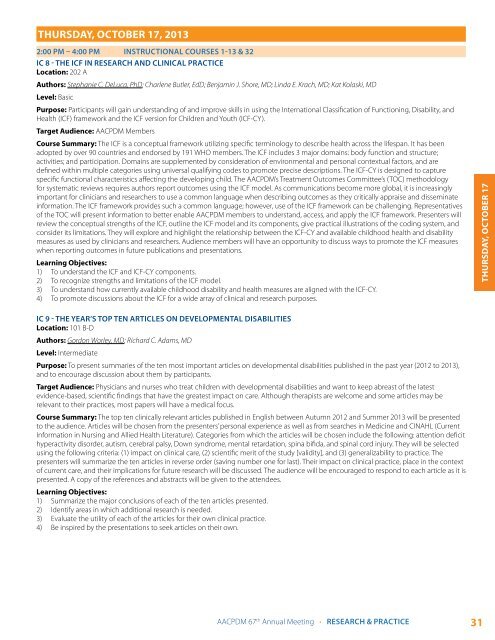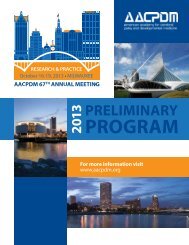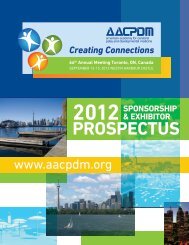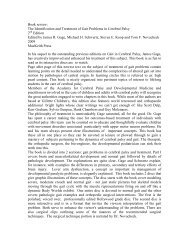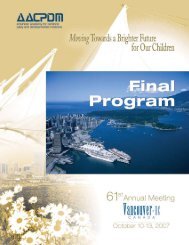ProgrAm - American Academy for Cerebral Palsy and ...
ProgrAm - American Academy for Cerebral Palsy and ...
ProgrAm - American Academy for Cerebral Palsy and ...
- No tags were found...
Create successful ePaper yourself
Turn your PDF publications into a flip-book with our unique Google optimized e-Paper software.
Thursday, October 17, 20132:00 pm – 4:00 pm Instructional Courses 1-13 & 32IC 8 - THE ICF IN RESEARCH AND CLINICAL PRACTICELocation: 202 AAuthors: Stephanie C. DeLuca, PhD; Charlene Butler, EdD; Benjamin J. Shore, MD; Linda E. Krach, MD; Kat Kolaski, MDLevel: BasicPurpose: Participants will gain underst<strong>and</strong>ing of <strong>and</strong> improve skills in using the International Classification of Functioning, Disability, <strong>and</strong>Health (ICF) framework <strong>and</strong> the ICF version <strong>for</strong> Children <strong>and</strong> Youth (ICF-CY).Target Audience: AACPDM MembersCourse Summary: The ICF is a conceptual framework utilizing specific terminology to describe health across the lifespan. It has beenadopted by over 90 countries <strong>and</strong> endorsed by 191 WHO members. The ICF includes 3 major domains: body function <strong>and</strong> structure;activities; <strong>and</strong> participation. Domains are supplemented by consideration of environmental <strong>and</strong> personal contextual factors, <strong>and</strong> aredefined within multiple categories using universal qualifying codes to promote precise descriptions. The ICF-CY is designed to capturespecific functional characteristics affecting the developing child. The AACPDM’s Treatment Outcomes Committee’s (TOC) methodology<strong>for</strong> systematic reviews requires authors report outcomes using the ICF model. As communications become more global, it is increasinglyimportant <strong>for</strong> clinicians <strong>and</strong> researchers to use a common language when describing outcomes as they critically appraise <strong>and</strong> disseminatein<strong>for</strong>mation. The ICF framework provides such a common language; however, use of the ICF framework can be challenging. Representativesof the TOC will present in<strong>for</strong>mation to better enable AACPDM members to underst<strong>and</strong>, access, <strong>and</strong> apply the ICF framework. Presenters willreview the conceptual strengths of the ICF, outline the ICF model <strong>and</strong> its components, give practical illustrations of the coding system, <strong>and</strong>consider its limitations. They will explore <strong>and</strong> highlight the relationship between the ICF-CY <strong>and</strong> available childhood health <strong>and</strong> disabilitymeasures as used by clinicians <strong>and</strong> researchers. Audience members will have an opportunity to discuss ways to promote the ICF measureswhen reporting outcomes in future publications <strong>and</strong> presentations.Learning Objectives:1) To underst<strong>and</strong> the ICF <strong>and</strong> ICF-CY components.2) To recognize strengths <strong>and</strong> limitations of the ICF model.3) To underst<strong>and</strong> how currently available childhood disability <strong>and</strong> health measures are aligned with the ICF-CY.4) To promote discussions about the ICF <strong>for</strong> a wide array of clinical <strong>and</strong> research purposes.THURsday, October 17IC 9 - THE YEAR’S TOP TEN ARTICLES ON DEVELOPMENTAL DISABILITIESLocation: 101 B-DAuthors: Gordon Worley, MD; Richard C. Adams, MDLevel: IntermediatePurpose: To present summaries of the ten most important articles on developmental disabilities published in the past year (2012 to 2013),<strong>and</strong> to encourage discussion about them by participants.Target Audience: Physicians <strong>and</strong> nurses who treat children with developmental disabilities <strong>and</strong> want to keep abreast of the latestevidence-based, scientific findings that have the greatest impact on care. Although therapists are welcome <strong>and</strong> some articles may berelevant to their practices, most papers will have a medical focus.Course Summary: The top ten clinically relevant articles published in English between Autumn 2012 <strong>and</strong> Summer 2013 will be presentedto the audience. Articles will be chosen from the presenters’ personal experience as well as from searches in Medicine <strong>and</strong> CINAHL (CurrentIn<strong>for</strong>mation in Nursing <strong>and</strong> Allied Health Literature). Categories from which the articles will be chosen include the following: attention deficithyperactivity disorder, autism, cerebral palsy, Down syndrome, mental retardation, spina bifida, <strong>and</strong> spinal cord injury. They will be selectedusing the following criteria: (1) impact on clinical care, (2) scientific merit of the study [validity], <strong>and</strong> (3) generalizability to practice. Thepresenters will summarize the ten articles in reverse order (saving number one <strong>for</strong> last). Their impact on clinical practice, place in the contextof current care, <strong>and</strong> their implications <strong>for</strong> future research will be discussed. The audience will be encouraged to respond to each article as it ispresented. A copy of the references <strong>and</strong> abstracts will be given to the attendees.Learning Objectives:1) Summarize the major conclusions of each of the ten articles presented.2) Identify areas in which additional research is needed.3) Evaluate the utility of each of the articles <strong>for</strong> their own clinical practice.4) Be inspired by the presentations to seek articles on their own.AACPDM 67 th Annual Meeting • Research & Practice 31


